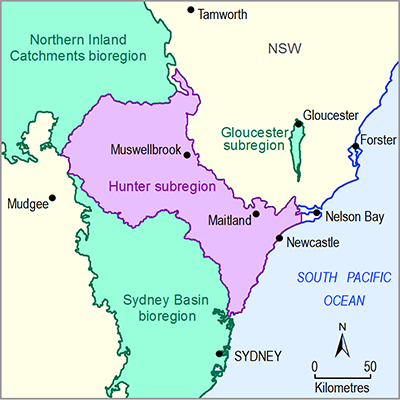Summary
The uncertainty analysis is consistent with the approach described in companion submethodology M09 (as listed in Table 1) for propagating uncertainty through models (Peeters et al., 2016). The same ten parameters investigated in the sensitivity analysis are considered in the uncertainty analysis of the groundwater model for the Hunter subregion.
Prior distributions for each parameter assume a uniform distribution, with no covariance of parameters. Groundwater level observations from a limited set of observation sites and observed streamflow data are used to constrain the parameter space. Parameter sets for groundwater levels are considered acceptable when they result in average groundwater level predictions that are within 10 m of observed historical averages at observation sites within 15 km of the prediction site. Results indicate that at many sites groundwater level predictions are not very sensitive to model parameters and provide little constraint on the prior distributions. In some areas, no parameter combinations were able to predict groundwater level observations. This most likely is due to local-scale factors not included in the regional modelling.
Acceptable parameter sets for modelled surface water – groundwater fluxes are those in which the average of the simulated historical surface water – groundwater flux is between the negative 20th percentile and 70th percentile of observed streamflow.
A number of parameters are constrained by the observation data: depth of riverbed, recharge, ratio of vertical to horizontal hydraulic conductivity, horizontal hydraulic conductivity and K_lambda. The other parameter values could not be constrained.
The posterior parameter sets must pass the acceptance thresholds defined for groundwater level and surface water – groundwater flux, except where the objective function for groundwater levels is less than 0.1 and only the latter acceptance threshold is required. Markov chain Monte Carlo sampling is repeated until 10,000 acceptable parameter sets are obtained to characterise the uncertainty of predictions of drawdown – maximum difference in drawdown between the coal resource development pathway (CRDP) and baseline, due to additional coal resource development (dmax) and year of maximum change (tmax).
More than three-quarters of the output locations have dmax less than 2 m; two-thirds have dmax less than 0.2 m. Additional drawdown is localised around the additional coal resource development mines. At a distance of about 20 km from the mine sites, there is only about a 5% probability of the dmax exceeding 0.2 m. In general, the tmax occurs relatively quickly in the immediate vicinity of the mines, but progressively later with increasing distance from the mines.
Local geological and hydrogeological information from the proposed Wallarah 2 mining area is used to demonstrate how the results from the regional parameter set can constrained to better represent the local situation. The use of local information reduces the extent of the predicted drawdown in the Wyong River catchment relative to the regional result set.
As in any modelling exercise, a number of assumptions and model choices have had to be made. A formal and systematic discussion of the rationale behind these assumptions in terms of data and resource availability and technical constraints as well as the perceived effect on the predictions highlighted that the largest sources of uncertainty in the predictions are the assigned mine pumping rates and the parameterisation of hydraulic properties. The latter issue is confounded as the available regional observation data set has limited potential to constrain the parameters the predictions are most sensitive to.

Product Finalisation date
- 2.6.2.1 Methods
- 2.6.2.2 Review of existing models
- 2.6.2.3 Model development
- 2.6.2.4 Boundary and initial conditions
- 2.6.2.5 Implementation of the coal resource development pathway
- 2.6.2.6 Parameterisation
- 2.6.2.7 Observations and predictions
- 2.6.2.8 Uncertainty analysis
- 2.6.2.9 Limitations and conclusions
- Citation
- Acknowledgements
- Currency of scientific results
- Contributors to the Technical Programme
- About this technical product
